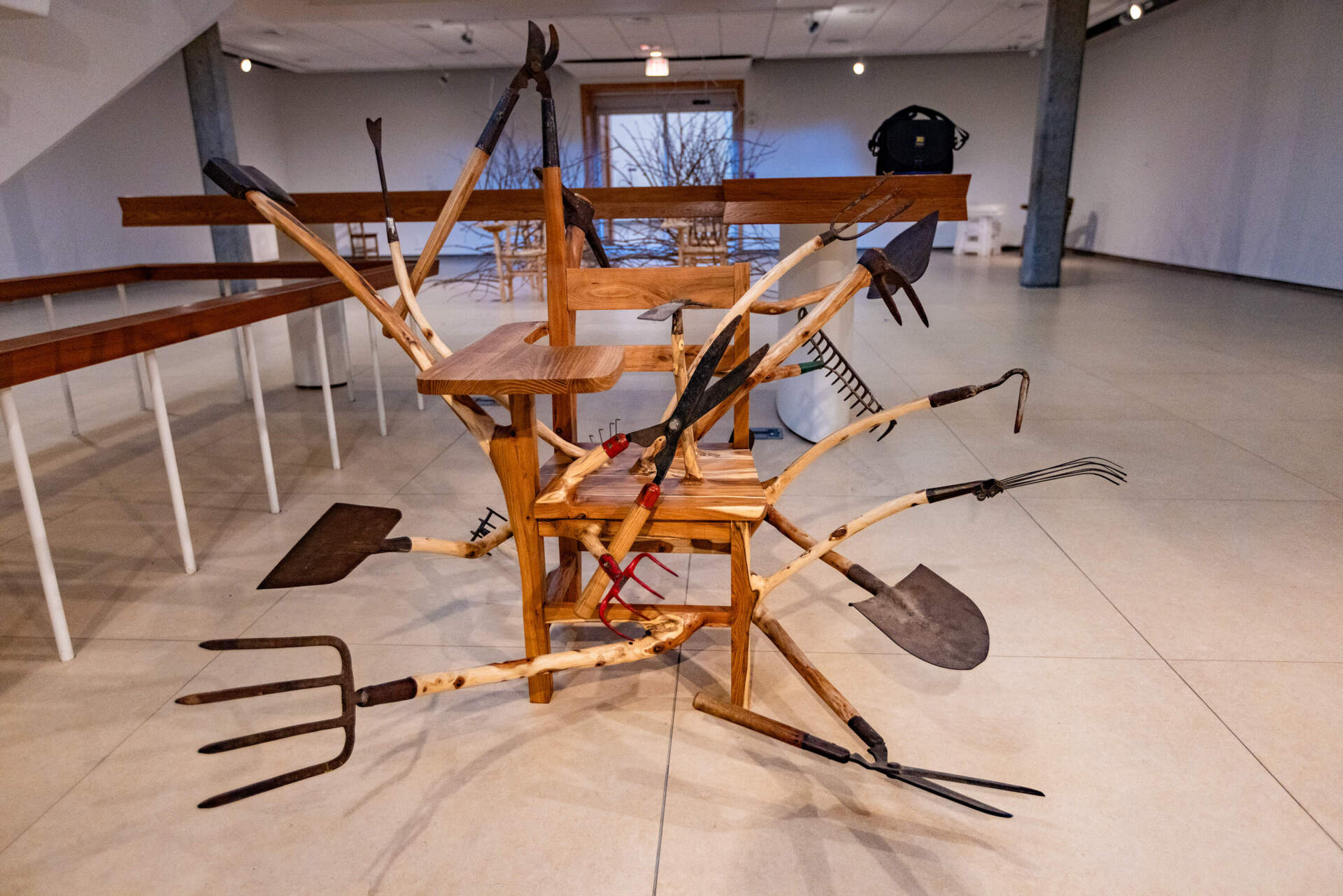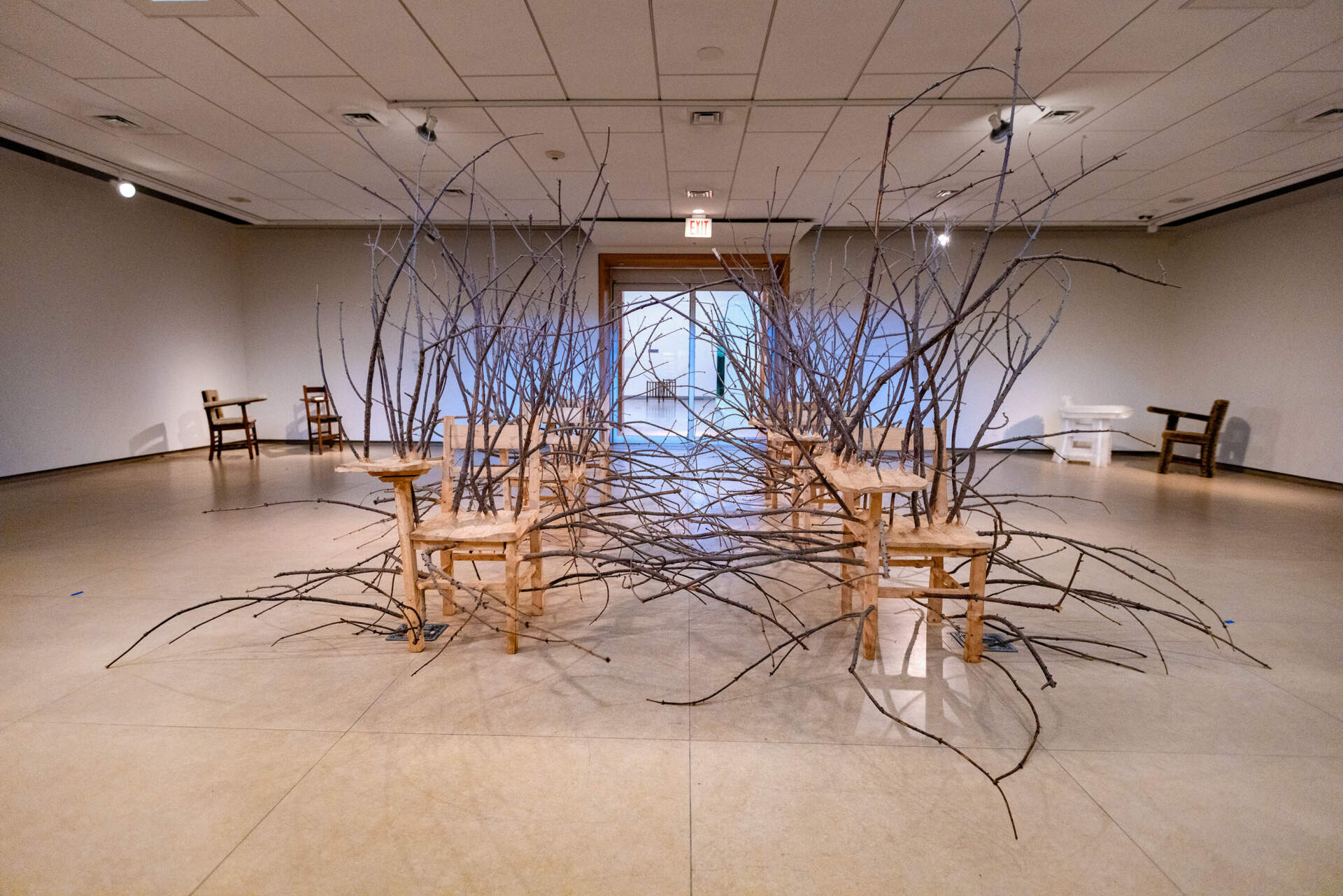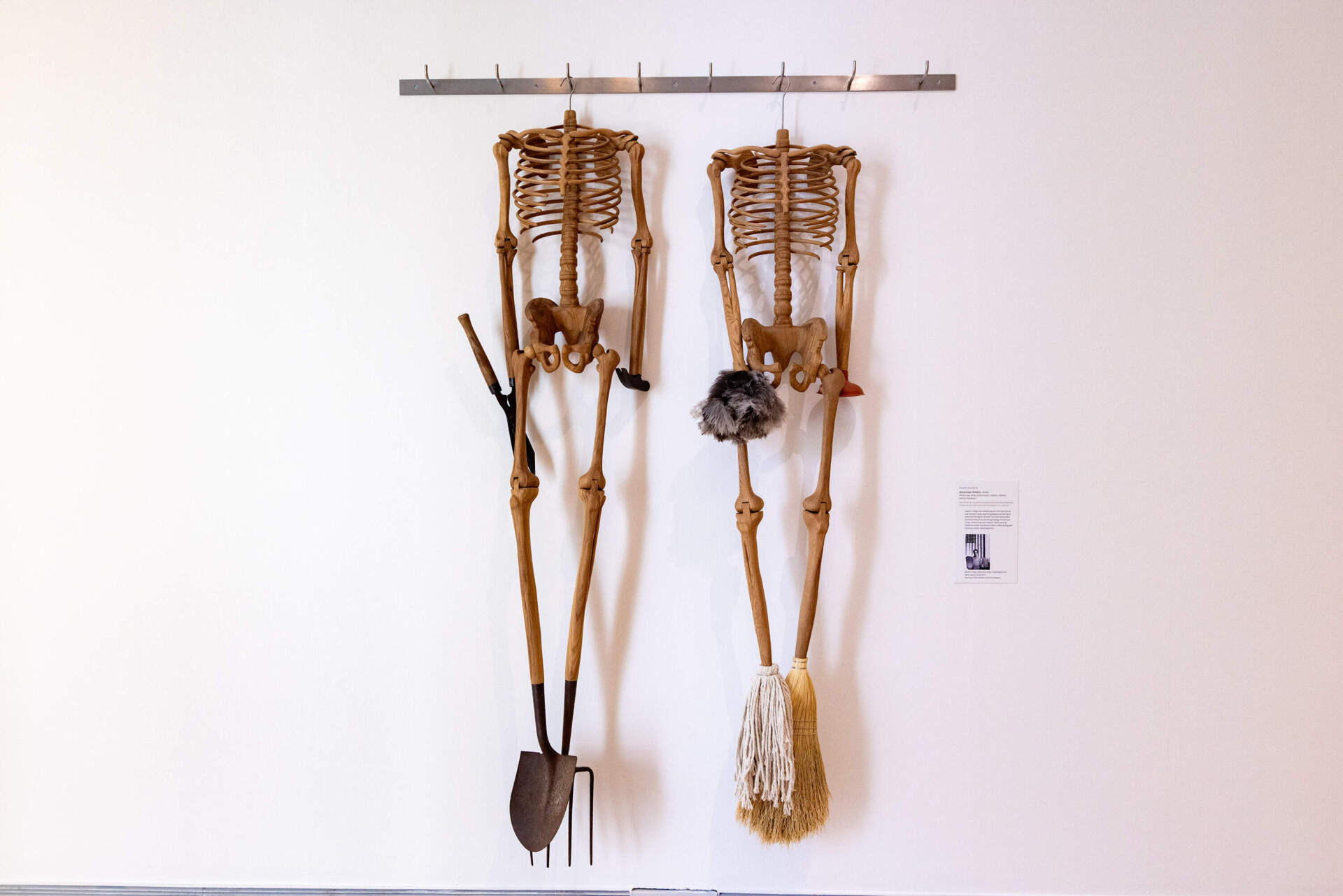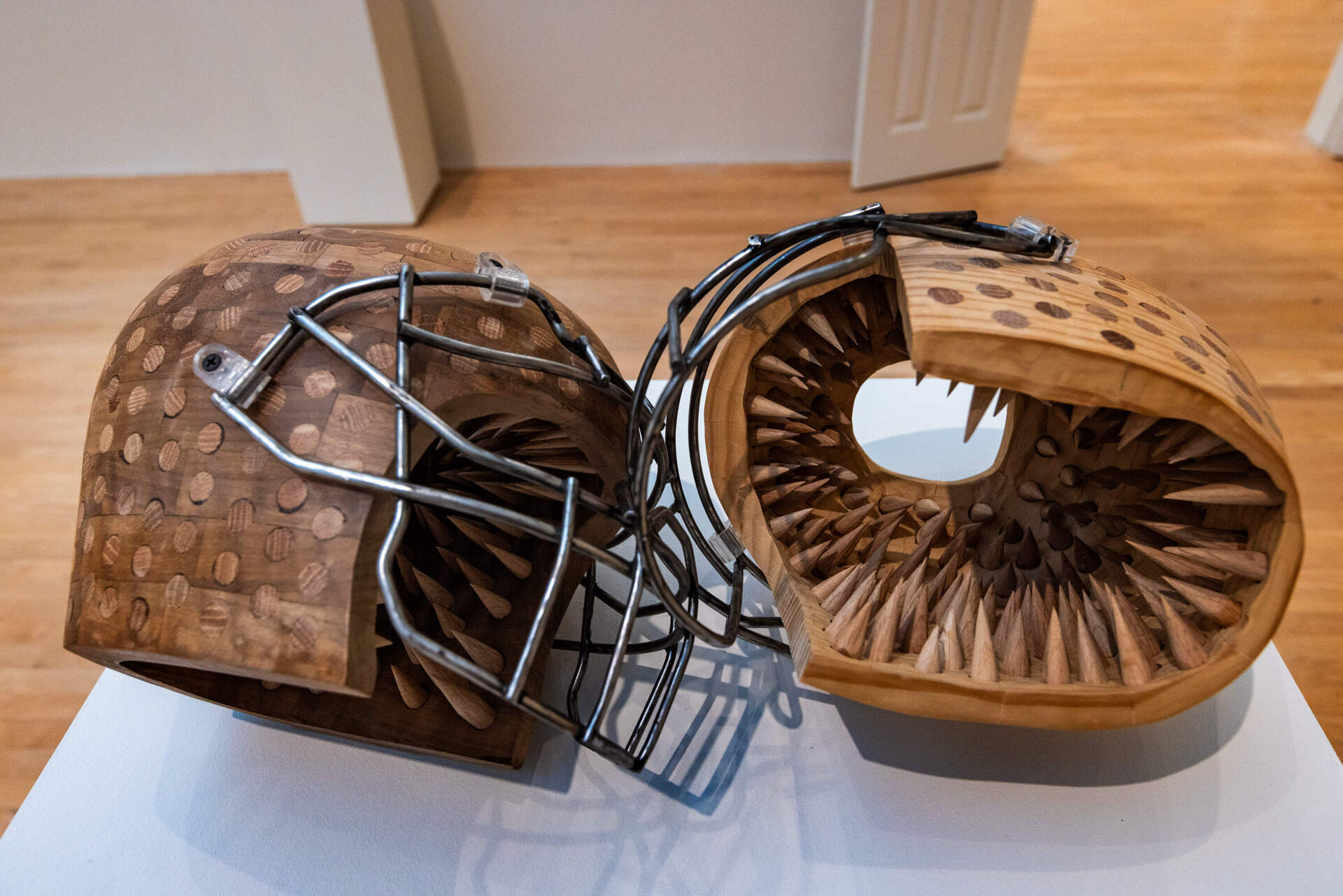Advertisement
Spiky and surreal, Hugh Hayden’s sculptures resist an easy reading
Resume
When you enter the Rose Art Museum’s main gallery, one of the first things you’ll see is a wooden chair with tools sprouting out of it in all directions: garden shears, a rusty pitchfork, a long ax.
“Many of them are sharp, many of them can wound you,” Rose Museum director Gannit Ankori said as we walked through “Hugh Hayden: Home Work” on the eve of the exhibit’s opening earlier this fall. We passed the menacing tool chair – a piece called “Finishing School” – and were confronted by two rows of school desks with huge tree limbs growing out of them, a classroom that seemed to transform before our eyes into a thicket of trees. Another pair of desks were covered all over in the coarse bristles of a cleaning brush, appearing at once soft and strange.

“They look like little animals,” Ankori observed. “A lot of [Hayden’s] work is surreal in that it metamorphoses into something that's alive, that's animated, and it's kind of freaky in a way, but funny in a way.”
The unsettling combination of threatening and alluring is on dizzying display throughout the Rose’s survey of Hayden’s prolific last decade: a baby’s crib lined with thorns, basketball hoops woven from human-like hair, a Burberry coat covered in tree bark. The objects evoke visceral reactions, but on closer inspection seem to offer a wry critique of American life.
The collection of strangely disfigured school desks – Ankori called it an “uncanny classroom” – was designed to create uneasy resonances with the exhibit’s location at an American university.
“The idea of higher education as being a pathway towards achieving the American dream is kind of explored, examined, and undermined, and questioned,” Ankori said. “So, this kind of chair, this kind of desk, this kind of classroom, you cannot inhabit, you cannot really sit here.”

The exhibit, which was curated by Ankori and the deCordova Sculpture Park and Museum’s Sarah Montross, offers a probing look at Hayden’s body of work as the 41-year-old artist rides a surge of admiring coverage for his large, surreal installations. The thicket of tree branch desks, for instance, is a smaller version of a much-lauded installation that appeared in New York’s Madison Square Park in 2022, called “Brier Patch.”
But “the pièce de résistance,” Ankori said, “is ‘Hedges.’”
As we stepped into the next section of the gallery, we were confronted with perhaps Hayden’s most famous piece, on display for only the second time since it debuted in 2019 at The Shed in New York. “Hedges” is a huge wooden model of a house, its facade sprouting with long tree limbs like a porcupine. Large mirrors on either side of the installation created the illusion of an infinite row of identical houses – a prickly challenge to the notion of home ownership as equally accessible to all. The effect was menacing.
Advertisement
“It's a typical suburban home that looks familiar,” Ankori said. “But then is scary and threatening and uncanny.”
There was that word again: uncanny. It is common to hear people describe Hayden’s work in alien terms. But the Texas-born artist sees these reactions as evidence of something like empathy.

“Sometimes becoming conscious of the lived experience of another person, and the absurdity or difficulty is so foreign to you, that that that is your response," Hayden said in an interview on a visit to Boston for the Rose exhibit opening. "That it's humorous or that it's uncanny.”
Hayden is a gregarious conversationalist who laughs easily and speaks in whimsical tangents. But his work betrays an unusual level of focus and attention to detail. The artist was employed for a time as an architect, and brings similar rigor to his sculptures. His pieces are painstakingly handcrafted, such that a tree branch or thorn protruding from a piece of furniture is an organic growth, with no hardware or seams to mar the impression of wholeness.
Recently, Hayden has turned his attention to the human form, carving exquisite wooden replicas of the human skeleton, though always altered in some unexpected or unsettling way. One of the newest sculptures on display at the Rose, “American Gothic,” features two skeletons side by side in an absurdist riff on the famed painting by Grant Wood, their limbs morphing into tools used for house or yard work – a shovel, a feather duster, a toilet plunger.

Hayden acknowledged that the piece might strike some as funny or macabre. But he explained that he liked skeletons because they functioned as a sort of blank canvas.
“For the average viewer, [a skeleton] has no identity,” Hayden said. “It has no gender, has no race, has no religion. It has no sexual orientation.”
Hayden, who is Black, frequently makes work that engages with race and masculinity. But he resists readings of his art that are strictly related to his identity.

“To someone who's really tuned in to what my work is about, they might see all these things that are more autobiographical in the work,” Hayden said. “But there are other people who can say, ‘Oh, this is like me. This is my grandmother. This is so-and-so.’”
Hayden offered that his expansive approach probably came from his background as an architect, a job that required him to design public buildings that would be welcoming to everyone. He seemed to revel in the idea that two people might look at one of his artworks and come to completely opposing conclusions about its meaning — even if it was commenting on a hot button issue, like policing in America. He noted that he’d received criticism that his own point of view wasn’t always apparent in his work.
"I often do have a side I would ... probably be more inclined towards," Hayden said. "But I think, also, some of the crazy beauty of this country is two people could be looking at the same thing, and have polar different views … and they're liking it for different reasons.”

Seeing work from the full sweep of his decade-long career all in one place at the Rose has induced its own shift in perspective. Some of Hayden's older pieces make him cringe now. Others just look different on the walls of the museum – like one sculpture, a basketball hoop woven from greenbriar vines, titled “Fee-fi-fo-fum.” A scraggle of briars cascades downwards from the backboard like a walrus mustache.
“It's shown up higher on the wall than I had shown it when it was in a gallery show,” Hayden said. “So it takes the height and the form of this sort of drooping, bushy basketball goal.”
It reminds him of a crucifix up there on the wall. Something about seeing the piece in a new context, he said, had transformed it into something else.
“Hugh Hayden: Home Work” at the Rose Museum is on view through June 1, 2025.
This segment aired on November 14, 2024.

